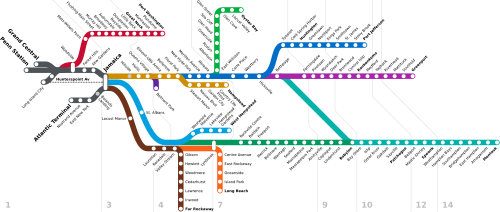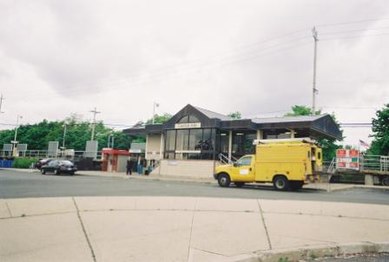List of Long Island Rail Road stations
 From Wikipedia - Reading time: 19 min
From Wikipedia - Reading time: 19 min

The Long Island Rail Road (LIRR) is a commuter railway system serving all four counties of Long Island, with two stations in the Manhattan borough of New York City in the U.S. state of New York. Its operator is the Metropolitan Transportation Authority of New York. Serving 301,763 passengers per day as of 2007[1] and 88.5 million riders for the year of 2008,[2] it is the busiest commuter railroad in the United States. With 324 passenger route-miles,[3] it spans Long Island from Atlantic Terminal in Brooklyn to Montauk station at the tip of the southern fork. Pennsylvania Station in Manhattan is the actual westernmost station of the Long Island Rail Road and its busiest station.
The system currently has 126 stations on eleven rail lines called "branches".[1][4] (Not included in this count are two additional stations that serve employees of the LIRR: Hillside Facility and Boland's Landing). Several stations see part-time service: Belmont Park, open on event days such as Belmont Stakes; Pinelawn, which exclusively serves cemeteries in its area and is served only during off-peak daytime hours; and Hunterspoint Avenue and Long Island City, which serve as terminals for several diesel trains during rush hours. The six stations on the Main Line east of Ronkonkoma also see very limited week-round trains, and are often used for recreation rather than commuting. Jamaica is a major transfer station between branches, as it provides the interchange from the eastern Long Island stations to the western New York terminals and vice versa. Other inter-branch transfer stations include Woodside, Mineola, Hicksville, Valley Stream, Lynbrook and Babylon. The Huntington, Ronkonkoma and Babylon stations provide transfers between electric train service and diesel train service within their respective branches, the Port Jefferson, Ronkonkoma/Greenport and Babylon/Montauk branches.
Lines
[edit]This list shows the western and eastern terminals of each LIRR service. There are 10 total services, plus one additional seasonal service (the Belmont Park Branch). Jamaica and the two employees-only stations are not included in the station counts below.
| Line | Stations | Western terminal[5] | Eastern terminal[5] | |
|---|---|---|---|---|
| Babylon Branch | 13 | Rockville Centre | Babylon | |
| Belmont Park Branch | 1 | Belmont Park (seasonal service only) | ||
| City Terminal Zone | 12 | Penn Station Long Island City Atlantic Terminal Grand Central Madison |
Jamaica | |
| Far Rockaway Branch | 11 | Locust Manor | Far Rockaway | |
| Hempstead Branch | 9 | Hollis | Hempstead | |
| Long Beach Branch | 6 | Lynbrook | Long Beach | |
| Montauk Branch | 16 | Babylon[6] | Patchogue / Montauk | |
| Oyster Bay Branch | 10 | East Williston | Oyster Bay | |
| Port Jefferson Branch | 16 | New Hyde Park | Huntington (electric) / Port Jefferson (diesel) | |
| Port Washington Branch | 13 | Woodside | Port Washington | |
| Ronkonkoma Branch | 14 | Bethpage | Ronkonkoma (electric) / Greenport (diesel) | |
| West Hempstead Branch | 6 | St. Albans | West Hempstead | |
Trunk lines
[edit]The LIRR has three trunk lines; each branch begins eastbound trips out of New York City via one of these lines.
| Trunk line | Stations | Western terminal | Eastern terminal | Branches |
|---|---|---|---|---|
| Atlantic Branch | 8 | Atlantic Terminal | Valley Stream | City Terminal Zone Far Rockaway Branch Long Beach Branch |
| Main Line | 29 | Penn Station or Grand Central Madison |
Greenport | City Terminal Zone Belmont Park Branch Hempstead Branch Oyster Bay Branch Port Jefferson Branch Port Washington Branch Ronkonkoma Branch |
| Montauk Branch | 33 | Long Island City | Montauk | West Hempstead Branch Babylon Branch Montauk Branch |
Station types and designs
[edit]The Long Island Rail Road has four types of station designs:
- Ground level (most common, platforms accessible via ramps and/or staircases)
- Elevated (all Babylon Branch stations and select others)
- Open-cut (select Port Washington Branch stations)
- Underground (only Penn Station, Atlantic Terminal, and Grand Central terminal)
- The Various Station Types Across the LIRR Network:
-
Roslyn is an example of a ground level LIRR station.
-
Babylon is an example of an elevated LIRR station.
-
Bayside is an example of an open-cut LIRR station.
-
Penn Station is an example of an underground LIRR station.
Additionally, some stations have station houses ("staffed", if open), whereas others do not ("unstaffed", if there is none or if the office is closed).[7] Some stations with station houses have ticketing offices open either part-time or full-time, whereas others do not have open ones. Additionally, some stations that lack station houses used to have them; these station houses were razed.[7][8]
Station house designs
[edit]The LIRR has an amalgam of different station house designs across its system. Many station houses built during the same time period (e.g., Mineola and Manhasset; 1920s), or as part of the same project (e.g., Central Islip and Deer Park; 1987 Hicksville–Ronkonkoma electrification project), share similar or identical designs.
- LIRR station houses of similar designs
-
Mineola's station house
-
Manhasset's station house.
-
Deer Park's station house, as seen prior to its 2010s modernization
-
Central Islip's station house.
Platform lengths
[edit]Platform lengths across the system vary from anywhere between 1+1⁄2 train cars (only found at a handful of stations in diesel territory) to 14 cars; most stations in the system feature platforms long enough for 10-12 railcars (C3, M3, M7, or M9), each of which are about 85 feet (26 m) long.[9][10]
Below are a sample of various stations with different platform lengths throughout the system:[9][10]
- Glen Street, located on the Oyster Bay Branch, has two side platforms, each 1+1⁄2-cars-long.
- Pinelawn, located on the Ronkonkoma Branch, has two side platforms, each 2-cars-long.
- Westwood, located on the West Hempstead Branch, has one side platform, which is 4-cars-long.
- Hampton Bays, located on the Montauk Branch, has one side platform, which is 6-cars-long.
- Hempstead, the terminus of the Hempstead Branch, has two sets of island platforms, each 8-cars-long.
- Woodmere, located on the Far Rockaway Branch, has two side platforms, each 10-cars-long.
- Northport, located on the Port Jefferson Branch, has one side platform, which is 12-cars-long.
- Bellmore, located on the Babylon Branch, has one island platform, which is 14-cars-long.
Historical preservation of stations
[edit]
Five LIRR stations are listed on the National Register of Historic Places: Sea Cliff, Oyster Bay, Farmingdale, Greenport and East Hampton. The St. James and Southampton stations are contributing properties to NRHP districts. Other stations that are not on the list are often cherished by local communities and treated as landmarks, such as Islip, Northport, Glen Street, and Great Neck. Roslyn, Glen Cove, and Locust Valley are other stations on the Oyster Bay Branch that are historic. Efforts to save the original East Williston station house in 2004 were unsuccessful when the structure was found to be too unstable, while the demolition of Amagansett's in 1965 brought public outcry throughout the Hamptons as well as among local railfans that has lasted for decades.[11][12][8]
The St. James station house, built in 1873, is the oldest such building constructed by the LIRR that remains standing. Hewlett's station house is older, but it was originally built by the South Side Railroad of Long Island in 1870. On the West Hempstead Branch, Malverne's station house is the only one originally built during the first two decades of the 20th century, although it is not recognized as a historic landmark. The elaborate Forest Hills station house was one of the few to avoid modernization during the mid-to-late 20th century and has retained the original grand decorative construction. When the Babylon Branch was elevated in the post-WWII era, former station houses in Wantagh and Lindenhurst were moved away from the tracks. The former Wantagh station was transformed into a museum, and also listed on the NRHP.
List of stations
[edit]This list contains all stations currently open on the Long Island Rail Road, including seasonal-use stations. Lines with colored boxes indicate branches which serve the station, while lines in parentheses indicate the physical line the station is located on, if applicable. For example, Amityville is physically located on the Montauk Branch but is served by Babylon Branch trains and only appears in the latter timetable.
| Station is accessible by wheelchair[13] | |
| Station meets all ADA accessibility requirements[13] | |
| Station does not meet ADA accessibility requirements[13] |
Disused and former stations
[edit]



These stations are either demolished or existing but not currently in use by the Long Island Rail Road. Several stations of the Rockaway Beach Branch and Far Rockaway Branch were taken over by the New York City Subway as the IND Rockaway Line in 1956.
See also
[edit]References
[edit]- ^ a b "The MTA Network: Public Transportation for the New York Region (Long Island Rail Road statistics)". New York Metropolitan Transportation Authority. Archived from the original on June 3, 2009. Retrieved May 29, 2009.
- ^ "Long Island Rail Road Annual Ridership". New York Metropolitan Transportation Authority. Archived from the original on March 13, 2009. Retrieved May 29, 2009.
- ^ Fischler, Stan. Long Island Rail Road. Voyageur Press. ISBN 9781616731564.
- ^ "2012-2014 LIRR Origin and Destination Report : Volume I: Travel Behavior Among All LIRR Passengers" (PDF). Metropolitan Transportation Authority. August 23, 2016. pp. 4–15(Sheet 15), WEEKDAY 1 of 3(Sheet 197)-WEEKDAY 3 of 3(Sheet 199). Archived (PDF) from the original on July 17, 2019. Retrieved March 29, 2020.
Data collection took place after the pretest determinations, starting in September 2012 and concluding in May 2014. ... 2012-2014 LIRR O[rigin and ]D[estination] COUNTS: WEEKDAY East/West Total By Station in Numerical Order [includes Hillside Facility, Boland's Landing, Pinelawn, Mets-Willets Point, but excludes Belmont Park]
- ^ a b Only physical terminal stations are listed here. Some trains originate/terminate at other stations during rush hours.
- ^ The Montauk Branch line is distinct from the Montauk Branch service. Babylon Branch trains run via the Montauk Branch east of Jamaica, but Montauk Branch service on the line begins at Babylon.
- ^ a b "MTA LIRR - Stations". lirr42.mta.info. Retrieved July 20, 2020.
- ^ a b "LIRR STATION HISTORY" (PDF). Retrieved July 20, 2020.
Depot building razed over several weeks during the month of August, 1964 (The East Hampton Star: 08/20/64). Replaced with wooden shed: August/ September, 1964.
- ^ a b "Visualizing LIRR Platform Lengths". www.subchat.com. Retrieved July 20, 2020.
- ^ a b https://i.imgur.com/anbIQ6l.jpg [bare URL image file]
- ^ "LIRR Amagansett". www.trainsarefun.com. Retrieved July 20, 2020.
- ^ The East Hampton Star: 08/20/64
- ^ a b c "MTA Guide to Accessible Transit: Accessible Stations in the MTA Network". New York Metropolitan Transportation Authority. Archived from the original on June 20, 2009. Retrieved June 21, 2009.
- ^ a b c Perlmutter, Emanuel (June 18, 1972). "L.I.R.R. Improving Service on All Lines Under a New Timetable". The New York Times. ISSN 0362-4331. Retrieved May 4, 2018.
- ^ a b "LONG ISLAND STATION HISTORY". Archived from the original on May 26, 2017. Retrieved February 18, 2015.
- ^ "Setauket Station Closing". Newsday. June 27, 1980. Retrieved March 19, 2023 – via Newspapers.com.
- ^ Nassivera, Joan (December 29, 1976). "LIRR Ending Service To Woodhaven Jan. 7". Newsday. Hempstead, New York. Retrieved July 15, 2021.
Further reading
[edit]- Vincent F. Seyfried, The Long Island Rail Road: A Comprehensive History, Part One: South Side R.R. of L.I., © 1961
- Vincent F. Seyfried, The Long Island Rail Road: A Comprehensive History, Part Two: The Flushing, North Shore & Central Railroad, © 1963
 KSF
KSF








